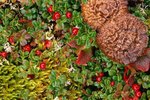
All paper wasps, yellow jackets and hornets are scientifically classified as wasps. Paper wasps include two native North American genera, Brachygastra and Mischocytarrus, and introduced European paper wasps of genus Polistes, who are similar in appearance to yellow jackets. Yellow jackets are in genus Vespula and are behaviorally different from paper wasps.
Cut of Their Coats
Polistes paper wasps are frequently mistaken for yellow jackets, but on close examination they look distinctly different. Both are black and yellow, fly and can sting. However, paper wasps have longer bodies with significantly more black and darker wings. Their wings and waists are thinner than that of a yellow jackets and their legs hang down noticeably while they're in flight. Yellow jackets have a smaller, fatter appearance.
Content of Their Nests
It's possible to distinguish yellow jackets from other wasps by their nest locations, which are almost always built in holes in the ground. Hornets and paper wasps build aerial nests -- globular structures made of chewed wood pulp and attached to surfaces with a tiny stem. European paper wasp nests are nearly spherical, and unlike hornets -- which look almost exactly like both European paper wasps and yellow jackets -- paper wasps don't build outer walls. Nest cells are open to the surrounding environment.
Nature of Their Dinners
Yellow jackets are predatory, scavenging omnivores. They eat fruit and nectar as well as insect prey, and they'll also swipe food from other animals, including human beings. This makes them frequent unwanted guests at picnics, outdoor festivities and garbage cans. Paper wasps are also predatory omnivores, but while they eat some plant nectar, the enormous bulk of their diet is insect prey. They feed their young almost exclusively on garden pest insect larvae. European paper wasps are such efficient agricultural predators, they're now considered key biological pest control species in the U.S., even though they're not native. Some intrepid gardeners go so far as to build nest boxes to encourage their presence.
Willingness to Attack
Paper wasps and yellow jackets have many behavioral similarities. Both are social and build nests annually. Both survive the winter only as pregnant females, and colonies of both include a queen mother, many sterile female workers and only a few parthenogenetically produced males. Finally, both are capable of delivering a venomous sting, but only yellow jackets are eager to use it. Yellow jackets live on the ground -- where everyone likes to stomp around, posing a continual threat to their nests. They tend to sting on a moment's notice. Paper wasps are nonaggressive and typically only sting in self-defense, when someone is actively disturbing their nest or accidentally crushing a wasp. Paper wasps are not considered a threat to humans, and entomologists and agricultural specialists recommend leaving their nests in place.
References
- Colorado State University Extension: European Paper Wasp
- Pennsylvania State University College of Agricultural Sciences: European Paper Wasp
- BugGuide.net: Subfamily Polistinae - Paper Wasps
- Texas A&M University AgriLife Extension: Paper Wasp
- Texas A&M University AgriLife Extension: Southern Yellowjacket
- Fairfax County Public Schools: Eastern Yellow Jacket - Vespula maculifrons
- University of California, Davis: Yellowjackets and Other Social Wasps
Resources
Photo Credits
-
Hemera Technologies/Photos.com/Getty Images
Writer Bio
Angela Libal began writing professionally in 2005. She has published several books, specializing in zoology and animal husbandry. Libal holds a degree in behavioral science: animal science from Moorpark College, a Bachelor of Arts from Sarah Lawrence College and is a graduate student in cryptozoology.


